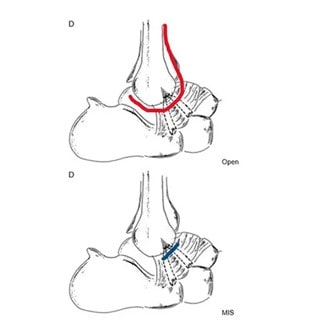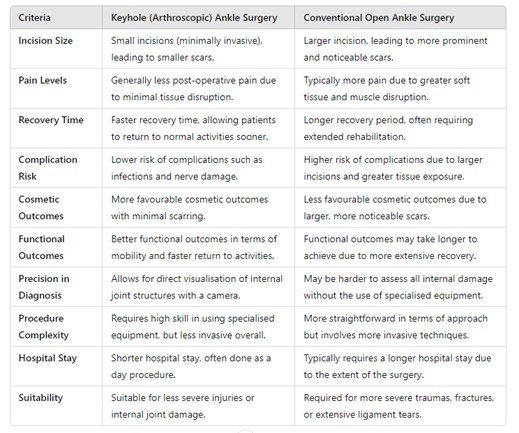
Experiencing an ankle sprain can be painful and debilitating. But when does an ankle sprain necessitate surgery? In most cases, conservative treatments like rest, ice, compression, elevation (RICE), physical therapy, and anti-inflammatory medications suffice. However, ankle surgery may become imperative in rare instances to alleviate pain and recover your ankle’s functionality. In this article, we’ll delve into the criteria for ankle surgery and the available options, helping you make an informed choice for your orthopaedic health.
What are Ankle Sprains?

Ankle sprains refer to an injury to the ligaments of the ankle, which happens when you roll, twist or turn your ankle in an awkward manner. They are usually graded mild, moderate or severe based on the degree of ligament injury and ankle instability.
When Should I See an Orthopaedic Surgeon in Singapore for Ankle Sprains?

As ankle sprains are one of the most common musculoskeletal injuries, we see a lot of patients with this type of ankle injury at Oxford Orthopaedics. Both moderate and severe ankle sprains may require specialist care, although the need is more pronounced in severe cases.
Here are several signs that indicate you should see an orthopaedic surgeon in Singapore for an ankle sprain:
- Severe Pain and Swelling: If the pain and swelling are intense and do not improve with basic home care (rest, ice, compression, elevation), it may indicate a more serious injury.
- Inability to Bear Weight: If you cannot put any weight on your ankle or have difficulty walking, this could be a sign of a severe sprain or fracture that requires specialist evaluation.
- Persistent Instability: Feeling like your ankle is giving way or if you experience repeated sprains may indicate chronic instability that needs surgical intervention.
- Deformity or Severe Bruising: Visible deformity, significant bruising, or changes in the shape of your ankle suggest a more complex injury requiring medical attention.
- Numbness or Tingling: These symptoms can indicate nerve involvement, necessitating a specialist’s evaluation.
- No Significant Improvement with Treatment: If there is no noticeable improvement after a few days of treatment, consulting an ankle surgeon can help determine the appropriate course of action.
Seeing an orthopaedic surgeon ensures a comprehensive assessment and appropriate management of the injury, preventing long-term complications.
When is Ankle Ligament Surgery Typically Required?
Ankle surgery is typically considered for injuries falling within these categories:
- Failed Conservative Treatment: If non-surgical treatments, including physical therapy, braces, and custom-made inserts or devices that you wear inside your shoes to correct foot problems (orthotics), prove ineffective even after months of rehabilitation and treatment, surgery becomes a viable option.
- Severe Trauma: Surgery becomes unavoidable in cases of severe trauma such as fractures or dislocations. When the ankle bone is shattered or the joint sustains severe damage, surgery becomes the sole means of restoring proper alignment and function. Additionally, surgery may be recommended when a severe ankle sprain is associated with other injuries, such as ankle cartilage damage or tendon rupture.
- Tendon and Ligament Tears: Ankle stability and function can be profoundly affected by tears in the Achilles tendon or ligaments. Surgical intervention, such as ankle ligament surgery, may be advised to repair or reconstruct these vital structures.
Ankle Surgery in Singapore: What is the Minimally Invasive 1cm Lasso Technique for Ankle Ligament Reconstruction and its Benefits?

The Minimally Invasive Surgical (MIS) “Lasso” technique stands out for its successful results in percutaneous ankle ligament reconstruction. It requires only a 1cm incision—significantly smaller than the 6-8cm incisions typically needed in open surgery. The procedure repairs the ankle ligaments with a single suture anchor, strengthening the repair by incorporating nearby tissue.
Benefits:
- Minimal pain and swelling post-surgery
- Swift recovery and an early return to high-level sports
- Reduced risk of skin complications and infections
- Less noticeable scars
What are the Surgical Approaches for Ankle Surgeries?
- Ankle Arthroscopy/ Keyhole Ankle Surgery: This minimally invasive procedure employs a small camera (arthroscope) and specialised instruments to assess and treat internal damage within the ankle joint.
- Conventional Open Ankle Surgery: This method requires a significantly larger incision, leading to more extensive damage to the surrounding soft tissue and muscles.

Summary
Ankle sprains occur when there is an injury to the ligaments of the ankle. You should see an orthopaedic surgeon in Singapore for ankle sprains if you experience severe pain and swelling that does not improve with home care, inability to bear weight, persistent instability, deformity or severe bruising, numbness or tingling, or no improvement after a few days of treatment. Ankle ligament surgery is typically required for failed conservative treatment, severe trauma, and tendon and ligament tears. If surgical ankle ligament repair is not viable because your condition is too severe, ankle reconstruction may be recommended.
Visit an Ankle Surgeon in Singapore

Ankle pain and discomfort can significantly lower one’s quality of life, hindering mobility and causing distress. Deciding if ankle surgery is necessary can be a complex decision. It is advisable to consult with an experienced orthopaedic surgeon, such as Oxford Orthopaedics’ Dr James Wee, who can assess your specific condition and provide tailored recommendations.
If you are contemplating whether ankle sprain surgery is right for you, you can schedule an appointment with Oxford Orthopaedics’ Medical Director and Senior Consultant Orthopaedic Surgeon, Dr James Wee. Leveraging over 20 years of clinical experience, he will provide you with specialised, tailored Advice on whether you require ankle surgery.
Dr James Wee is a skilled and experienced ankle sprain specialist based in Singapore. Having completed his fellowship in Ankle Surgery at the prestigious Royal National Orthopaedic Hospital in London, Dr Wee is an expert in using arthroscopic (keyhole) and minimally invasive surgical techniques in the treatment of not only ankle sprains but also ankle arthritis. For instance, he co-developed the minimally invasive “Lasso” technique for percutaneous ankle ligament reconstruction, facilitating rapid recovery and early return to high-level sports and dance activities.
References:
- Sprained ankle – Symptoms and causes. Mayo Clinic. Published August 11, 2022. https://www.mayoclinic.org/diseases-conditions/sprained-ankle/symptoms-causes/syc-20353225
- WebMD. Ankle Sprain. WebMD. Published 2007. https://www.webmd.com/pain-management/ankle-sprain
- Tay GT, J Wee et al. A Novel Percutaneous Modified Brostrom-Gould Technique for Lateral Ankle Instability Using the Lasso Technique. Techniques in Foot & Ankle Surgery, Jan 2021.
